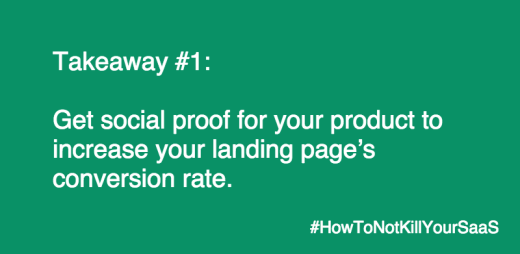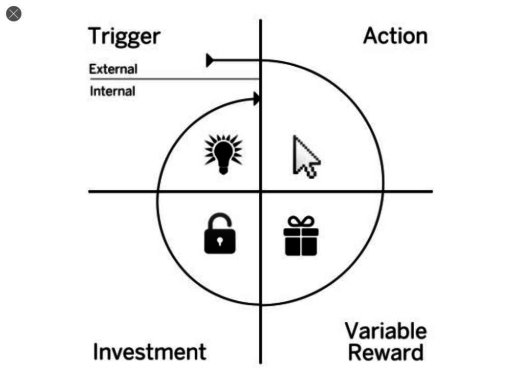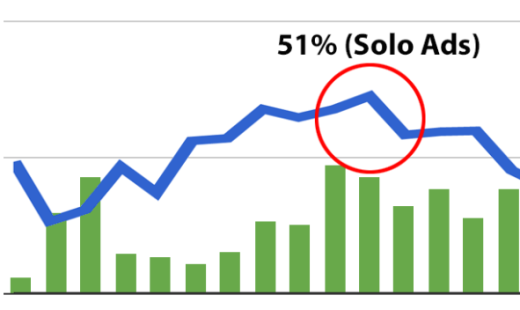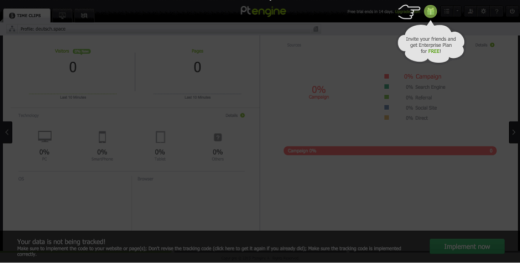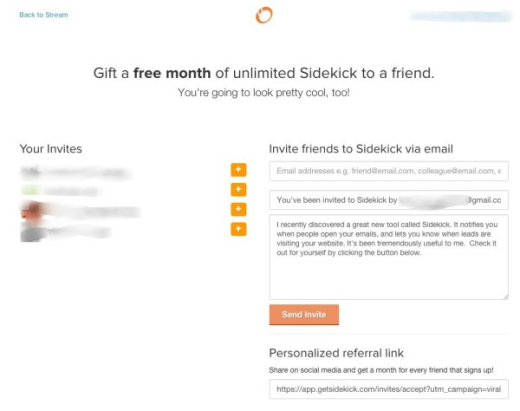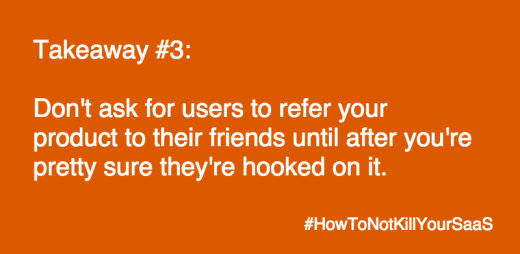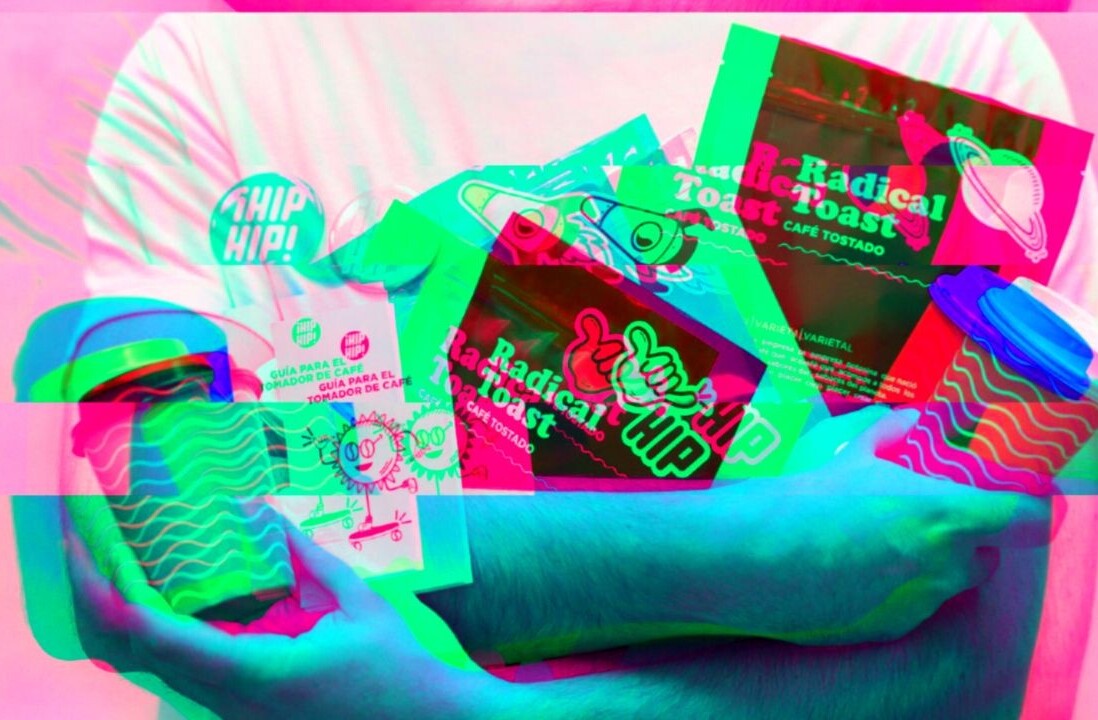
Do you work for a startup? Are you a marketer? If so, you may be addicted to PGH–Premature Growth Hacking.

What is PGH addiction?
The “P” stands for “premature.” Growth hacking by itself is fine, when done at an appropriate moment in a startup’s development. It gets you more users and revenue by using creativity–rather than relying too heavily on paid advertising.
When is the “appropriate moment” for growth hacking? When you have a product that onboards, engages, and retains new incoming users.
But before that moment, growth hacking is a waste of time and effort.
I struggled with PGH last year, and it put our startup at grave risk. Thankfully, after rehab and a lot of research, I learned that hacking growth should not be your startup’s first priority.
This is my story. Here’s what you’ll be able to do after you read it:
- The 3 critical things you need to get for your startup from building engagement into your product.
- How to build engagement into your product (case studies from 2 billion-dollar SaaS companies + details of our failure story and how to avoid our costly mistakes.)
- The 3 laws of startup survival I learned while kicking my PGH addiction.
Bad funnels: What happens when you try to hack growth too early.
Take a look at our funnel through October of last year. This is what a startup suffering from PGH addiction looks like:
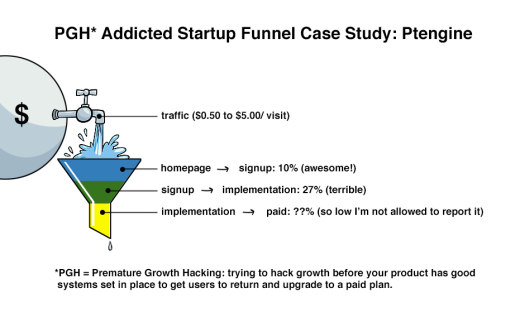
Here’s why this all went down.
Our investors told us they wanted to see us sustain user growth. This was a precondition for for our pre-A funding.
So I focused on “user growth” (which to them meant “signups”). See that funnel above? I only focused on that top (blue) layer.

I managed to get a 10% conversion rate for web traffic to signups. Ten percent is good. All we had to do, from my perspective, was keep costs down for traffic. (Wrong. You’ll see why.)
I took us from 1,000 to 10,000 signups in about 6 months. Our investors were pleased enough with that rate to give us $9 million in pre-A funding.
Here’s our growth from Week 1 to Week 44 of my tenure with Ptengine, with a campaign-by-campaign breakdown of growth.
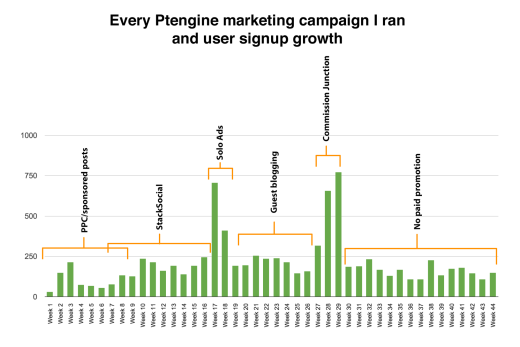
#Winning…? Not so fast.
Acquiring 1000% growth in your user base is winning. But losing 73% of them before they ever use your product? Not winning.
Look at the next layer of the funnel again–the green one. It shows you what happened to users after they signed up.

I only got 27% of our signups to implement our tracking code on their website. So only 27% of people who signed up ever truly used our product.
Also, those huge spikes of growth around Weeks 17 and 29? Those campaigns brought in the most signups, but resulted in the lowest implementation rates. Take a look:
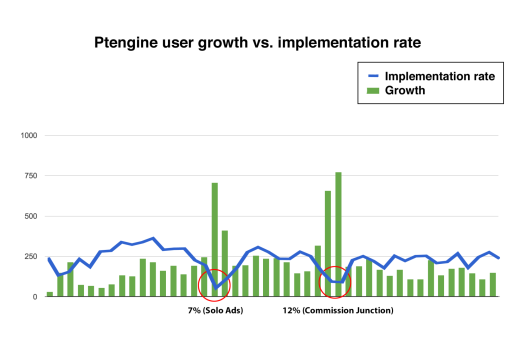
In other words, the more I focused on hacking growth, the less our users stuck around.
And look at the yellow layer. That’s conversions from active users to paid ones. It was so low I’m not even allowed to report it, but let’s just say it was in the low single digits. (Eek.)
But is engagement even a marketer’s job?
Getting users to implement our tracking code… getting implemented users to pay for the software… I never thought any of that was “my job.” I figured that was the product team’s job.
I knew that the process for upgrading to a paid membership was like going through a maze for our users.
But I never made it a priority to improve that because the investors had told me their key metric was signup growth.
But both product signups and engagement are my responsibility as a marketer. Because if you really want sustained growth, the only way to ensure it is to get users to engage with, and pay with, your product.
The 3 rewards user engagement bring your product that ensure sustained growth
- Reward #1: Social proof. If people don’t use your product they’ll never love it. And if they don’t love your product, you lose out on glowing testimonials and case studies.
That means you don’t have those social proof assets to show visitors to your homepage. And that results in fewer conversions from visitor to user to customer.
On the flip side, imagine how much Brian Dean’s conversion rates benefit from his social proof:
Having legit reviews from Entrepreneur and Forbes increases visitor confidence that using your product will benefit their life. Even more so a testimonial that complimentary from the likes of Neil Patel. (He’s one of the most respected figures in internet marketing today.)
If people don’t naturally use and love your product, you get none of this social proof. Your only recourse is to pay media outlets and reviewers to promote your product.

- Reward #2: Sales. This is one of those “Duh!” common sense things you lose when signups don’t use your product. But it’s not the money from sales you should be worried about losing. It’s their commitment to your product.
When users pay for a product or service, they become much more invested in it, which makes using the product more habit-forming. Anyone who’s ever played fantasy sports, paid for a date, or gambled for money knows. Once you put your hard-earned cash down, you become much more committed to the outcome.
This is part of Nir Eyal’s cycle of habit-forming products in the awesome book Hooked. The investment part of the cycle is critical for ensuring users continue to use your product. Paying for a product makes people more likely to put in more effort to master it.

We found this to be true with our StackSocial deal. We gave StackSocial users a 97% discount on a lifetime subscription to Ptengine, and over the next couple weeks our implementation rate jumped 2x:

We literally changed NOTHING about Ptengine during this campaign. The ONLY difference was that StackSocial users paid $49 for a lifetime subscription to the Pro version of our software. Before that deal all users started off with a free plan.

- Reward #3: Referrals. Nobody is going to refer your product to a friend when they haven’t used it and loved it.
Our product team tried as hard as they could to get new users to refer Ptengine to their friends. Right at the point of signup–before users even had a chance to try out our product.
That approach didn’t work.
Our offer: Refer 5 friends and you gain access to an extended trial of the Enterprise version of Ptengine!

Again, the main problem is that this offer popped up before the user ever got to use Ptengine. Unsurprisingly, very few people went for it.
People work hard to build relationships–they’re not going to burn them just so they can get an upgrade to an app they’ve never even tried before.
Compare our offer, for example, to Sidekick’s referral offer. (Sidekick is Hubspot’s cool browser extension that sends you an alert at the exact moment a receiver opens an email you sent them.)
Sidekick is free for a limited trial, and during that trial those notifications become addictive (because of the variable reward part of the Hooked equation). At the end of the trial, you suddenly get a popup offering to extend it. All you have to do is get someone you invite to install Sidekick.

Now that is an effective way to ask for referrals. By then you’ve already formed a habit of using the product. Then you face the crisis of losing access to it. This strongly motivates you to take action and send out referrals (or upgrade to a paid plan).
Reviewing those three things to focus on before you start aggressively growth hacking:
- Get social proof for your product to increase your landing page’s conversion rate.
- Get users to invest (ideally money) in your product–it makes them much more likely to stick around.
- Get users hooked on your product–then motivate them to refer it to their friends.
But why not just rely on VC funding?
You might be able to get initial funding rounds from an investor with high signup rates. But as you go from your A round of funding to your B round, investors will move the goalposts.
Instead of talking only about user acquisition numbers, investors will look at new metrics. Metrics like lifetime value (LTV) and (paid) customer acquisition cost (CAC). Those numbers are all about retention and engagement, two things I should have been focusing on from the beginning.
Instead, I was deep in the throes of my sinister PGH addiction.
Investors always end up focusing on numbers like LTV and CAC because they want to either sell your company or IPO. And when that happens, they want the highest P/E ratio possible.
- P/E ratio: the value of your company divided by your annual sales. The higher your P/E ratio, the higher valuation you can get relative to sales.
For example, Slack is worth $3 billion on annual sales of $30 million. So their P/E ratio is 100. I repeat: Slack’s P/E ratio is 100. Compare that to other tech stocks:

By comparison, Facebook’s P/E ratio at IPO was around 90.
Slack’s P/E ratio and growth rate are super high for the same reason: Slack has mastered user engagement.
Startups look at Slack’s growth rate with a sense of awe–arousal even. Slack’s marketing team seemed to recognize this when they released the chart showing their growth in gif format. To give people a sense of awe at the absolute scale of their success. The way they roll it out all slowly and seductively reminds me of opening a centerfold:

But their viral growth had nothing to do with marketing. They didn’t spend a penny on marketing until November 2014–after they were already valued at a billion dollars.
Their growth had everything to do with how good they were at getting users to stick around, learn how to use Slack, and eventually refer their friends and coworkers.
Once Slack mastered that, then they started marketing. They hired Bill Macaitis as CMO eleven months in, during November 2014. I envy Macaitis so much. All he had to do was take a raging fire of growth and splash around some gasoline to turn it into an inferno:
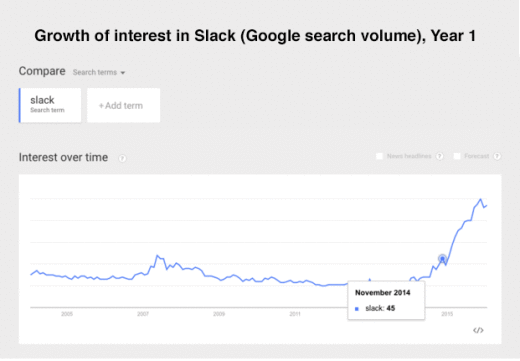
So we did things completely opposite from Slack in 3 main ways:
- I spent my first 6 months aggressively promoting our product–trying to hack growth. Slack spent their first months focusing on getting new users addicted to the product. (Check out Samuel Hulick’s step-by-step in teardown of their onboarding process here.)
- I didn’t fix our payment system or revise our plans to encourage people to upgrade. That meant users didn’t feel invested in the product and didn’t bother to learn it. (Other than the ones who bought the StackSocial deal.) In contrast, Slack managed to get a free-to-paid conversion rate of 30%. Nir Eyal called that rate “one of the highest in the enterprise business.”
- I failed to fix our silly referral system–the one that asked people to tell their friends about our product before they tried it. Slack’s referral system was much better. (Check Brandon Gains’ teardown of it here.)
Take a look at how that all translates into active user growth during Year 1, Slack vs Ptengine. For one thing, Slack managed about 1000x our growth. For another, their growth rate (so fast they measured it as week-on-week) was exponential–especially after they started actively marketing the product:
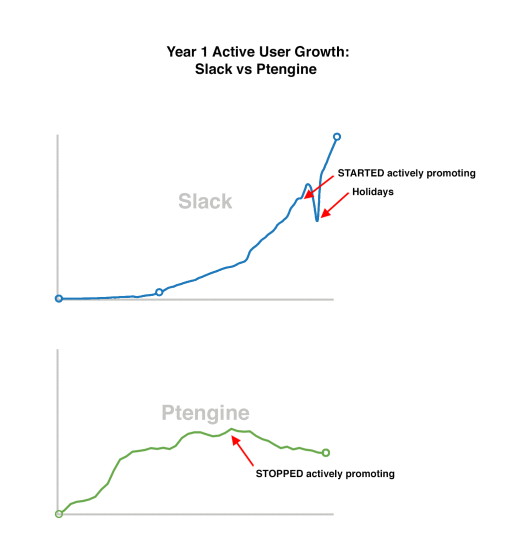
Around my 6th month at Ptengine I realized how much we were suffering from PGH. By the 7th month, I stopped attempting to hack growth altogether. We had to make some dramatic changes to our product.
In the last part of this article, I’ll share the 3 laws of startup survival.
The 3 laws of startup survival
- Find great mentors and taste the pain.
- Recruit qualified early adopters; don’t succumb to HiPPOs and whales.
- Always release your product as an MVP first.
Law #1 of startup survival: Find great mentors and taste the pain.
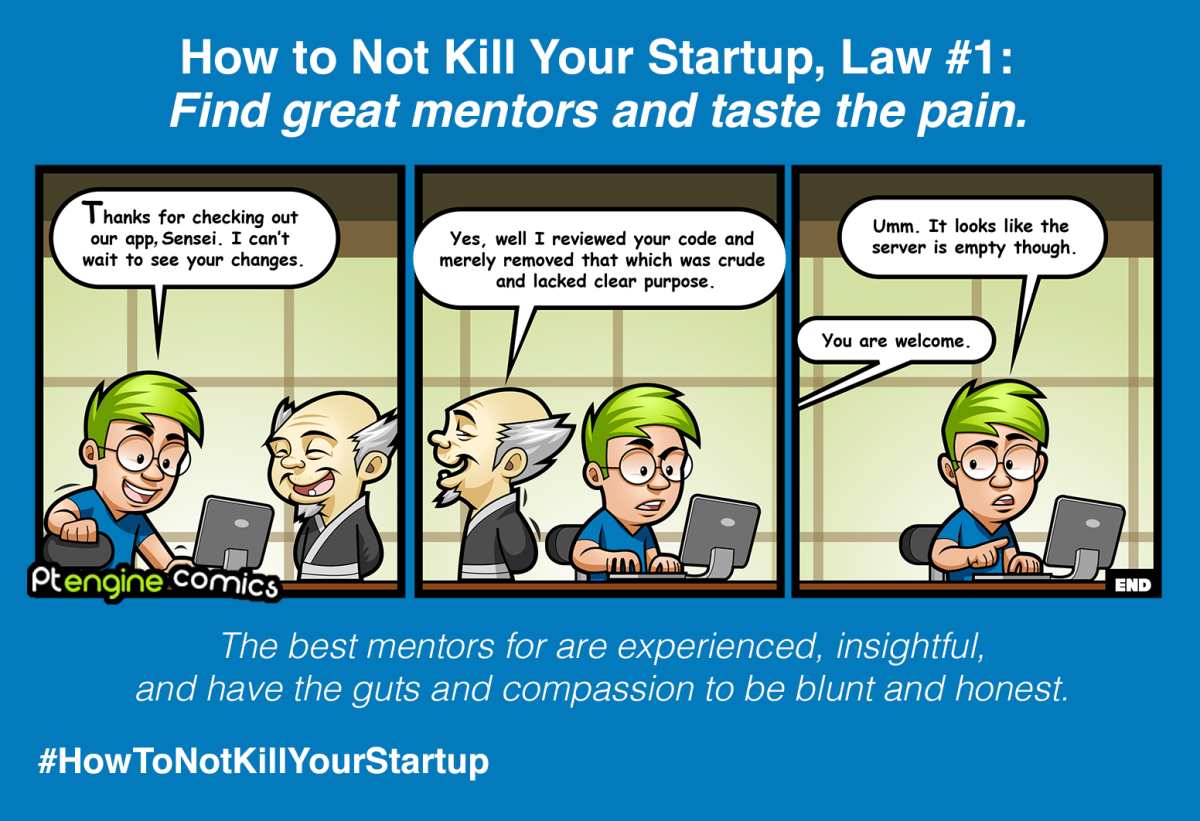
Tweet this comic – #HowToNotKillYourStartup
One of my startup’s biggest issues is taking criticism. We’re passionate about our product. So in the past, when somebody talked crap about it, we defended it.
That’s wrong. I had to change that.
Criticism is almost always someone’s way of telling you they want you to succeed. I’d much rather have criticism than no feedback at all. The only thing you need to worry about when someone criticizes your product is, “Does she have an objectively valid point?”
And a great way to ensure someone’s criticism is correct is to find an experienced mentor. One who’s willing to spend the time and sincerely critique your product is your first step to startup success.
A huge turning point for me was getting our app critiqued by Pete Koomen. Pete is the co-founder of Optimizely, an app that played a major role in getting President Obama elected in 2008 and has brought conversion optimization and A/B testing into the marketing mainstream. Along the way, they’ve raised more than $146 million.
Pete and his team are crushing it.
Their product is also a lot like Ptengine. It’s a SaaS. It helps marketers do CRO. It’s somewhat complex. And it has a tracking code that has be implemented onto a website to work.
In just 20 minutes, Pete was able to tell me one major reason our implementation rate was so low. We had to do one thing with new users. His exact words: “Take them from zero to mind blown in as short a time as possible.”
How to take users from zero to mind blown in as short a time a possible
Even after someone signs up for your product, you have to keep selling. And with selling, showing is better than telling.
When Optimizely first started out, A/B testing was still a new concept for most marketers. So Pete built a demo for the product that new users could play with so they would get the value of their product right away.
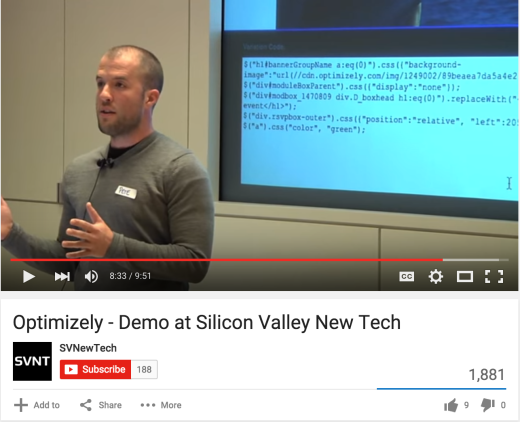
Pete Koomen, CTO of Optimizely showing–not telling–his product’s benefits in a demo.
Pete didn’t hold back in his criticism of our onboarding process. He was blunt and direct, and thankfully so. Our onboarding process was terrible.
At first his critique was a bit hard to accept, but I managed to set my ego aside and take his advice. I built a demo that walks users through Ptengine to show how an eCommerce website uses heatmaps to increase their sales.
Good thing I did. As a direct result, our implementation rate has already increased from 25% to 45%. (By the way, if you want more conversions for your website, check out that demo here.)
Think about that–I cut our customer acquisition nearly in half, all thanks to one conversation with a kickass mentor.
(By the way, if you’re curious how I got Pete to help me, and how you can get a great mentor for your product, read my guide. Also, read this post if you want to find out how another mentor helped me build a $150k/mo SEO SaaS back in 2011.)
Law #2 of startup survival: Recruit qualified early adopters; don’t succumb to hippos and whales.
As I said earlier, you do have to verify that your mentor’s criticism is correct. The best way to do that is listen to lots of feedback from early adopters of your product.
I’m going to show you the 3 channels I found awesome early adopters at. But first, I have to warn you not to make our mistake.
We put too much stock in what HiPPOs and whales said about our product.
Don’t feed the HiPPOs!
HiPPO stands for “Highest Paid Person’s Opinion” or “Highest Paid Person in the Office”. Normally this is the CEO, CTO, or some other C-level executive.
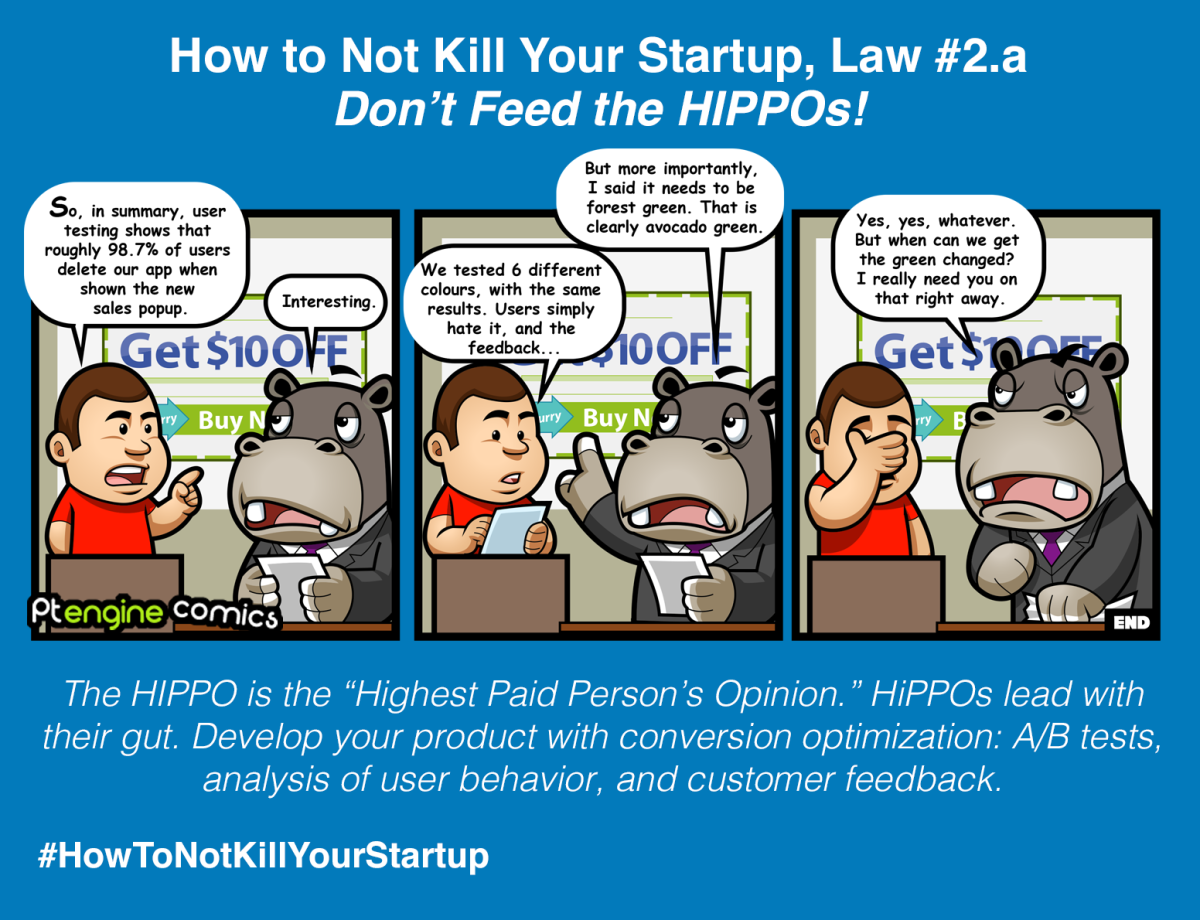
Tweet this comic – #HowToNotKillYourStartup
HiPPOs don’t bother looking at data or customer feedback. They let their gut make all the decisions. And this can be disastrous. (It nearly bankrupted 100 year-old JCPenney.)
Our HiPPO situation was a result of good intentions. Our CEO has really good instincts and lots of contacts in the Japanese digital marketing industry, so his input helped a lot in Ptengine’s early days.
But once we moved into the U.S. heatmap and analytics market, he realized we needed to get feedback from American users. That’s a big reason they hired me.
Don’t let the whales run the aquarium!
Whales are your startup’s biggest clients. While you need to avoid actively turning them off, if you only develop your app with their needs in mind, you end up alienating the rest of your users.
In most cases during the early days of your product, you want to make it simpler to use. You have to reduce the barrier of entry for new users to acquire a habit for your product.
Whales don’t want simplicity. They’re already familiar with your product. They want more complexity and more features–in particular, more tools that only specifically apply to their business needs.
That’s bad. If you do what they want, you’ll end up turning off new users. Which will make you more dependent on your whales. It becomes a vicious cycle.
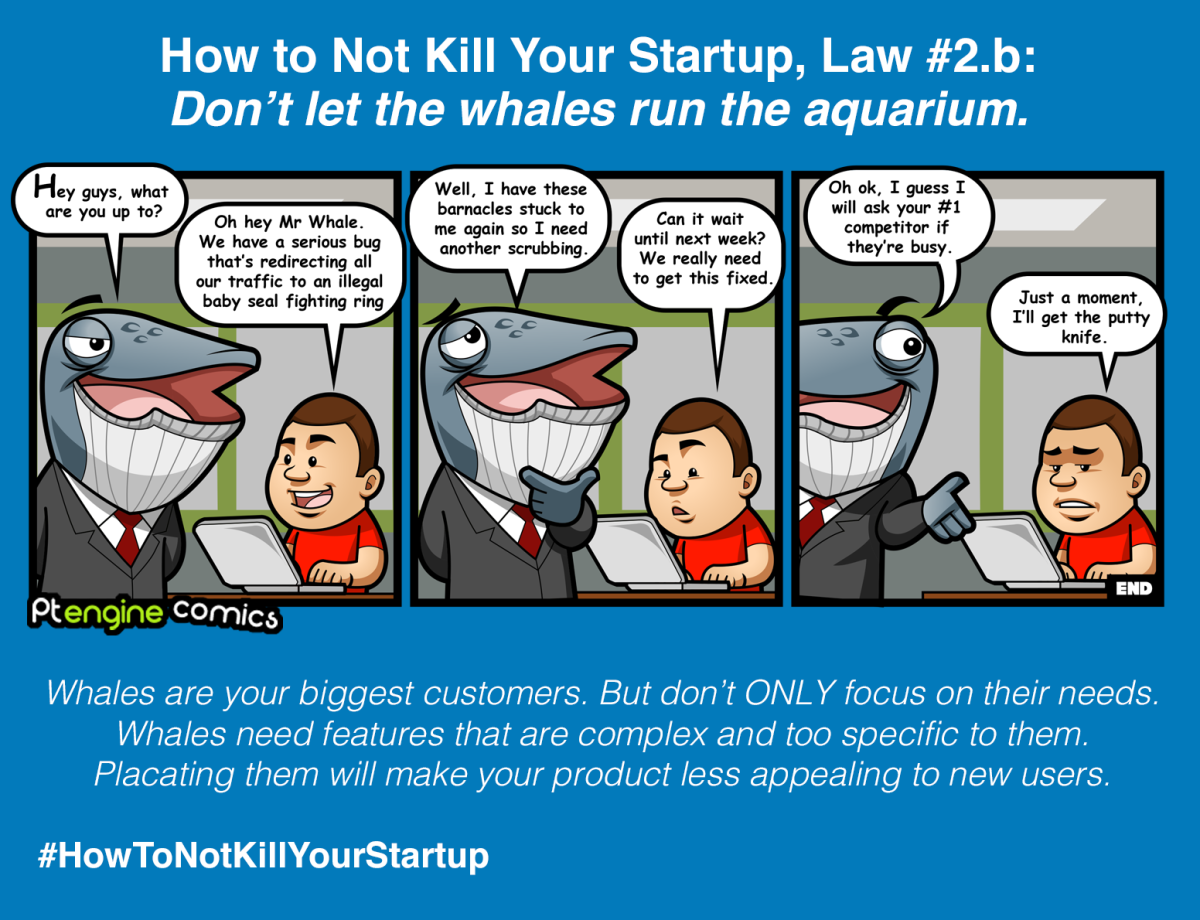
Tweet this comic – #HowToNotKillYourStartup
Ptengine had a lot of legacy customers in Japan with super specific needs. When I first arrived, our developers seemed to be caught in a constant cycle of working on bugs for features that 95%+ of our users didn’t need. That meant they had no bandwidth for things like demos and tutorials, optimizing the speed of the software, or new features that the U.S. market demanded.
Finally, in July, I managed to convince the product team to start focusing on making Ptengine more friendly to new users and agile enough to accommodate adding new features that were in demand.
This was all based on feedback from dozens of early adopters I recruited.
How to recruit early adopters of your product
I have a full explanation of my tactics for getting quality early users here, but in general I use three sources: conferences, inbound marketing, and coaching platforms like Clarity.
Again, the goal of recruiting these people is to verify the feedback you got from your mentor. Just blindly following a major figure from your industry without validating his advice can sink you. That’s what happened to Wisdomly, a startup that failed despite being funded and having a former VC and Google engineer on its team and spending every dollar frugally. They pivoted their app based on the advice of an advisor/investor who then disappeared when his advice turned out to be wrong.
Law #3 of startup survival: Always release your product as an MVP first.
Perfectionism is for HiPPOs–people who are driven by pride and attention to detail.
Don’t be a perfectionist with your product. Make an MVP first.
MVP stands for “minimum viable product.” This means it has the minimum functionality to either validate it or prove that it’s not necessary.
With every release, hit up your mentors and early adopters first. Based on their feedback, you’ll know whether the MVP is worthy of further effort.
Better to find that out sooner than later. Sooner, you can get to work on something else before you run out of money. Later, you’ve wasted months tweaking a product/features that either a) nobody wants or b) already exists in another, more mature product.
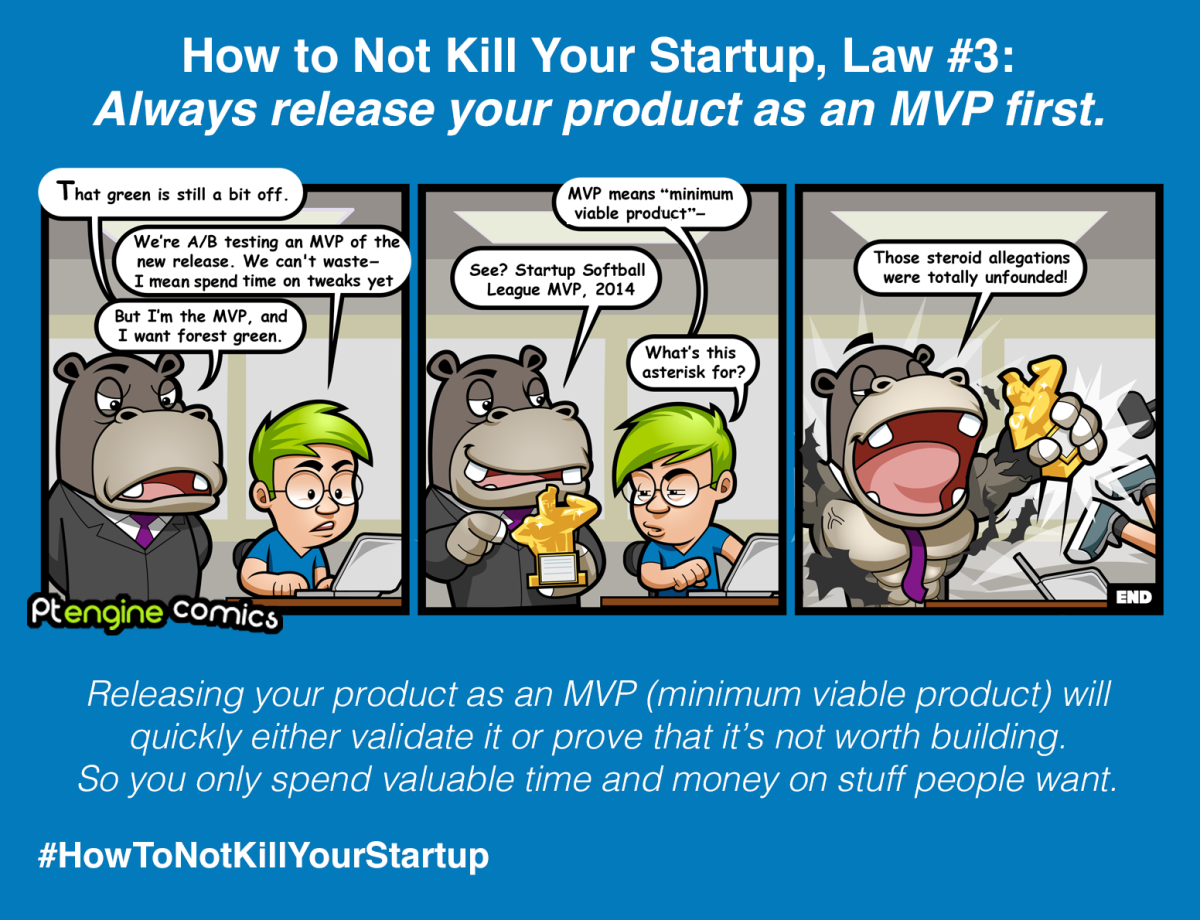
Tweet this comic – #HowToNotKillYourStartup
In my first year here, we went through months of development working on features for Ptengine without first validating the market need for them. Most of those features were for HiPPOs or whales, and we abandoned all of them in our November release of Ptengine 3.0.
It’s gut-wrenching to think of the time and money we wasted on those features. We could have spent that effort on many more useful features that would have helped differentiate us from our (many) competitors.
For the future, we’re going to use “vaporware” to validate all new proposed features for Ptengine. Definition: software that doesn’t exist, but allows you to get signups and feedback anyway. Tom Tunguz outlines how Optimizely and Sendwithus both used vaporware to validate their business models. In both cases, their inexpensive vaporware releases got them the early adopters they needed to set a clear path for their startup’s future.
Conclusion: Before you start growth hacking, ensure your survival by building a product that keeps your users hooked.
To summarize the major lessons I’ve learned in my first year at Ptengine:
- Be like Slack and Hubspot’s Sidekick. Make your product habit-forming. That way, it will get the social proof, sales, and referrals it needs to achieve sustainable user growth. Venture capital is not a long-term option.
- Once your product is habit-forming, then and only then should you start thinking about growth hacking.
- Find great mentors who have the experience and willingness to harshly and correctly criticize your product. Take in their criticism and don’t be defensive.
- Validate your mentors’ advice by recruiting early adopters through conferences, inbound marketing, and coaching platforms. Avoid dependence on the micromanagement of HiPPOs or the demands from whales.
Always start with a minimum viable product (MVP) in the beginning. Release each new product and feature to your mentors and early adopters ASAP to get their feedback–before you start tweaking.
Get the TNW newsletter
Get the most important tech news in your inbox each week.


